C Programming and Data Structures: Unit IV: a. Non-Linear Data Structures - Trees
Binary Search Tree
Definition, Operations, Algorithm, Structure, Example C programs | Non-Linear Data Structures
Binary search tree is a binary tree in which the nodes are arranged in specific order. That means the values at left subtree are less than the root node value. Similarly the values at the right subtree are greater than the root node.
Binary Search Tree
AU:
Dec.-18,19, Marks 13
Binary
search tree is a binary tree in which the nodes are arranged in specific order.
That means the values at left subtree are less than the root node value.
Similarly the values at the right subtree are greater than the root node. Fig.
5.6.1 represents the binary search tree.

The
binary search tree is based on binary search algorithm.
1. Operations on Binary Search Tree
1.
Insertion of a node in a binary tree
Algorithm:
1.
Read the value for the node which is to be created and store it in a node
called New.
2.
Initially if (root!=NULL) then root-New.
3.
Again read the next value of node created in New.
4.
If (New->value < root->value) then attach New node as a left
child of root otherwise attach New node as a right child of root.
5.
Repeat steps 3 aand 4 for constructing required binary search tree completely.
void
insert(node *root,node *New)
{
if(New->data
<root->data)
{
if(root->left==
NULL) ← Attaching left node to the current node.
root->left=New;
else
insert(root->left,New);
}
if(New->data>root->data)
{
if(root->right
== NULL)
root->right=New;
← If the root node has already some left child, then move onto left subtree.
else
insert(root->right,New);
srit
aupaib au fo
}
}
While
inserting any node in binary search tree, first of all we have to look for its
appropriate position in the binary search tree. We start comparing this new
node with each node of the tree. If the value of the node which is to be
inserted is greater than the otolob totes a value of current node we move onto the
right subbranch otherwise we move onto the left subbranch. As soon as the
appropriate position is found we attach this new node as left or right child
appropriately.

In
the Fig. 5.6.2 if we want to insert 23. Then we will start comparing 23 with
value of root node i.e. 6. As 23 is greater than 10, will will move on right
subtree. Now we will compare 23 with 20 and move right, compare 23 with 22 and
move right. Now compare 23 with 24 but it is less than 24. We will move on left
branch of 24. But as there is NULL node as left child of 24, we can attach 23
as left child of 24.
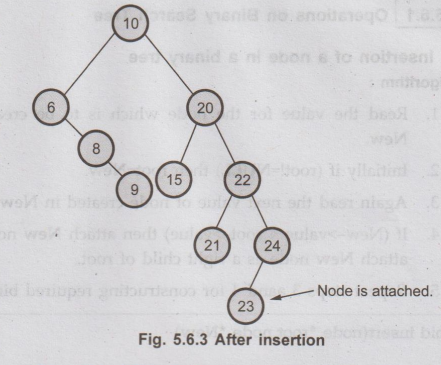
2.
Deletion of an element from the binary tree
For
deletion of any node from binary search tree there are three cases which are
possible.
i.
Deletion of leaf node.
ii.
Deletion of a node having one child.
iii.
Deletion of a node having two children.
Let
us discuss the above cases one by one.
i.
Deletion of leaf node
This
is the simplest deletion, in which we set the left or right pointer of parent
node as NULL.
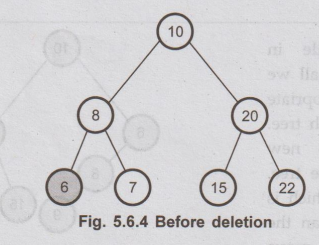
From
the above tree, we want to delete the node having value 6 then we will set left
pointer of its parent node as NULL. That is left pointer of node having value 8
is set to NULL.

ii.
Deletion of a node having one child
To
explain this kind of deletion, consider a tree as shown in the Fig. 5.6.6.
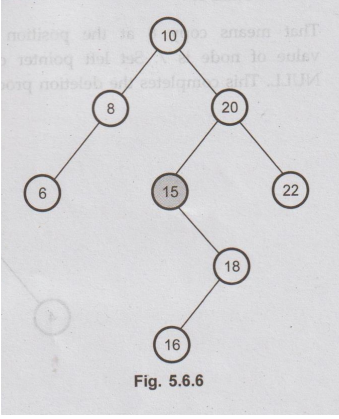
If
we want to delete the node 15, then we will simply copy node 18 at place of 15
and then set the node free. The inorder successor is always copied at the
position of a node being deleted.
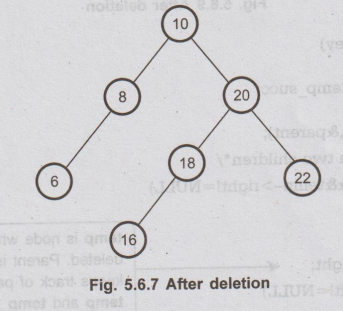
iii.
The node having two children
Again,
let us take some example for discussing this kind of deletion.
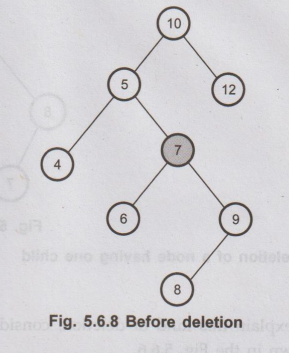
Let
us consider that we want to delete node having value 7. We will then find out
the inorder successor of node 7. The inorder successor will be simply copied at
location of node 7. Thats it!
That
means copy 8 at the position where value of node is 7. Set left pointer of 9 as
NULL. This completes the deletion procedure.
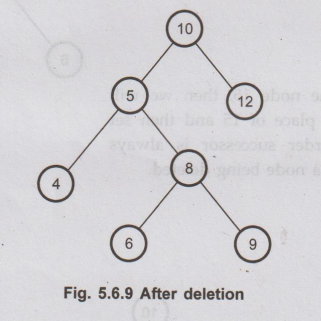
void
del(node *root,int key)
{
node
*temp, *parent,*temp_succ
temp=search(root,key,&parent);
/*deleting
a node with two children*/
if(temp->left!=
NULL&&temp->right!= NULL)
{
parent=temp;
temp_succ=temp->right;
← temp is node which is to be deleted. Parent is a node which keeps track of
parent of node temp and temp_succ is for keeping track of success of temp.
while(temp_succ->left!=
NULL)
{
parent=temp_succ;
temp_succ=temp_succ->left;
← Moving to leftmost subtree
}
temp->data=temp_succ->data;
← Copying the successor node's data to temp node. Thus content of temp node
gets deleted.
if(temp_succ
== parent->left)
parent->left
= NULL;
else
parent->right
= NULL;
printf("
Now Deleted it!");
return;
}
/*
deleting a node having only one child*/
/*The
node to be deleted has left child*/
if(temp->left!=
NULL &&temp->right == NULL)
{
if(parent->left==temp)
parent->left=temp->left;
← Finding parent of temp
else
parent->right-temp->left;
temp=NULL;
free(temp);
printf("
Now Deleted it!");
return;
}
/*The
node to be deleted has right child*/
if(temp->left==NULL
&&temp->right!= NULL)
{
if(parent->left
== temp)
parent->left-temp->right;
else
parent->right-temp->right;
temp=NULL;
free(temp);
printf("
Now Deleted it!");
return;
}
/*deleting
a node which is having no child*/
if(temp->left==NULL
&&temp->right == NULL)
{
3.
Searching a node from binary search tree
In
searching, the node which we want to search is called a key node. The key node
will be compared with each node starting from root node if value of key node is
greater than current node then we search for it on right subbranch otherwise on
left subbranch. If we reach to leaf node and still we do not get the value of
key node then we declare "node is not present in the tree".
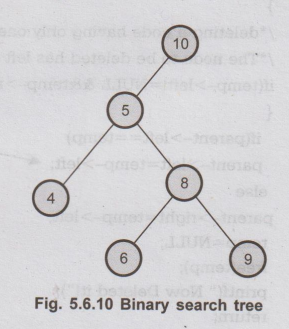
In
the above tree, if we want to search for value 9. Then we will compare 9 with
root node 10. As 9 is less than 10 we will search on left subbranch. Now
compare 9 with 5, but 9 is greater than 5. So we will move on right subbranch.
Now compare 9 with 8 but as 9 is greater than 8 we will move on right
subbranch. Now we read the node value as 9. Thus the desired node can be
searched. Let us see the 'C' implementation of it.
The
routine is as given below -
Non-recursive
search routine
node
*search(node *root,int key,node **parent)
{
node
*temp;
temp=root;
while(temp!=
NULL)
{
if(temp->data==key)
{
printf("\n
The %d Element is Present",temp->data);
return
temp;
*parent=temp;
← via to mexport/a/, Mang
if(temp->data>key)
← if current node is greater than key
temp-temp->left;
← Search for the left subtree.
else
temp-temp->right;
}
return
NULL;
}
We
can display a tree in inorder fashion. Hence the complete implementation is
given below along with appropriate output.
/*****************************************
Program
for Implementation of Binary Search Tree and
perform
insertion deletion, searching, display of tree.
*****************************************/
#include
<stdio.h>
#include
<conio.h>
#include
<stdlib.h>
typedef
struct bst
{
int
data;
struct
bst *left, *right;
}node;
void
insert(node *,node *);
void
inorder(node *);
node
*search(node *,int,node **);
void
del(node *,int);
void
main()
{
int
choice;
char
ans='N';
int
key;
node
*New,*root, *tmp, *parent;
node
*get_node();
root
= NULL;
clrscr();
printf("\n\t
Program For Binary Search Tree ");
do
{
printf("\n1.Create\n2.Search\n3.Delete\n4.Display");
printf("\n\n
Enter your choice :");
scanf("%d",
&choice);
switch(choice)
{
case
1:do
{
New
get_node();
printf("\n
Enter The Element ");
scanf("%d",
&New->data);
if(root
== NULL) /* Tree is not Created */
root=New;
else
insert(root,New);
printf("\n
Do u Want To enter More Elements?(y/n)");
ans=getch();;
}while(ans=
='y');
break;
case
2:printf("\n Enter The Element Which You Want To Search");
scanf("%d",
&key);
tmp=search(root,key,&parent);
printf("\n
Parent of node %d is %d",
tmp->data,parent->data);
break;
case
3:printf("\n Enter The Element U wish to Delete");
scanf("%d",
&key);
del(root,key);
break;
case
4:if(root == NULL)
printf("Tree
Is Not Created");
else
{
printf("\n
The Tree is: ");
inorder(root);
}
break;
}
}while(choice!=5);
}
node
*get_node()
{
node
*temp;
temp
(node *)malloc(sizeof(node));
temp->left=NULL;
temp->right=NULL;
return
temp;
}
/*This
function is for creating a binary search tree */
void
insert(node *root,node *New)
{
if(New->data
<root->data)
{
if(root->left==
NULL)
root->left=New;
else
insert(root->left,New);
}
if(New->data>root->data)
{
if(root->right
== NULL)
root->right=New;
else
insert(root->right,New);
}
}
/*
This
function is for searching the node from binary Search Tree
*/
node
*search(node *root,int key,node **parent)
{
node
*temp;
temp=root;
while(temp!=
NULL)
{
if(temp->data=
=key)
{
printf("\n
The %d Element is Present",temp->data);
return
temp;
}
*parent=temp;
if(temp->data>key)
temp-temp->left;
else
temp-temp->right;
}
return
NULL;
}
/*
This
function is for deleting a node from binary search tree. There exists three
possible cases for deletion of a node
*/
void
del(node *root,int key)
{
node
*temp, *parent,*temp_succ;
temp=search(root,key,&parent);
/*deleting
a node with two children*/
if(temp->left!=
NULL&&temp->right!= NULL)
{
parent=temp;
temp_succ-temp->right;
while(temp_succ->left!=
NULL)
{
parent=temp_succ;
temp_succ=temp_succ->left;
← Finding successor node of temp node
}
temp->data=temp_succ->data;.
← Copy the data of successor node to temp node
if(temp_succ
= = parent->left)
parent->left
= NULL;
else
parent->right
= NULL;
printf("
Now Deleted it!");
return;
}
/*deleting
a node having only one child*/
/*The
node to be deleted has left child*/
if(temp->left!=
NULL &&temp->right= = NULL)
{
if(parent->left
== temp)
parent->left=temp->left;
else
parent->right-temp->left;
temp=NULL;
free(temp);
printf("
Now Deleted it!");
return;
}
/*The
node to be deleted has right child*/
if(temp->left==
NULL &&temp->right!= NULL)
{
if(parent->left
== temp)
parent->left-temp->right;
← Parent's left child is deleted.
else
parent->right-temp->right;
temp=NULL;
free(temp);
printf("
Now Deleted it!");
return;
}
/*deleting
a node which is having no child*/
if(temp->left==NULL
&&temp->right == NULL)
:{
if(parent->left=
=temp)
parent->left=
NULL;
else
parent->right=NULL;
← Simply make parent's left pointer NULL, so that left child of parent is
deleted.
printf("
Now Deleted it!");
return;
}
}
/*
This
function displays the tree in inorder fashion
*/
void
inorder(node *temp)
{
if(temp!=
NULL)
{
inorder(temp->left);
printf("%d",temp->data);
inorder(temp->right);
}
}
Output
Program
For Binary Search Tree
1.
Create
2.
Search
3.
Delete
4.
Display
Enter
your choice :1
Enter
The Element 10
Do
u Want To enter More Elements?(y/n)
Enter
The Element 8
Do
u Want To enter More Elements?(y/n)
Enter
The Element 9
Do
u Want To enter More Elements?(y/n)
Enter
The Element 7
Do
u Want To enter More Elements?(y/n)
Enter
The Element 15
Do
u Want To enter More Elements?(y/n)
Enter
The Element 13
Do
u Want To enter More Elements?(y/n)
Enter
The Element 14
Do
u Want To enter More Elements? (y/n)
Enter
The Element 12
Do
u Want To enter More Elements? (y/n)
Enter
The Element 16
Do
u Want To enter More Elements? (y/n)
1.
Create
2.
Search
3.
Delete
4.
Display
Enter
your choice :4
The
Tree is: 7 8 9 10 12 13 14 15 16
1.
Create
2.
Search
3.
Delete
4.
Display
Enter
your choice :2
Enter
The Element Which You Want To Search16
The
16 Element is Present
Parent
of node 16 is 15
1.
Create
2.
Search
3.
Delete
4.
Display
Ex.
5.6.1 Define binary search tree. Draw the binary search tree for the following
input. 14, 15, 4, 9, 7, 18, 3, 5, 16, 4, 20, 17, 9, 14, 5
Sol.
Binary Search Tree (Refer section 5.6)


Ex.
5.6.2 Define a binary search tree and construct a binary search tree. With
elements {22, 28, 20, 25, 22, 15, 18, 10, 14). Give recursive search algorithm
to search an element in that tree.
Sol.
Binary Search Tree (Refer section 5.6)
Example
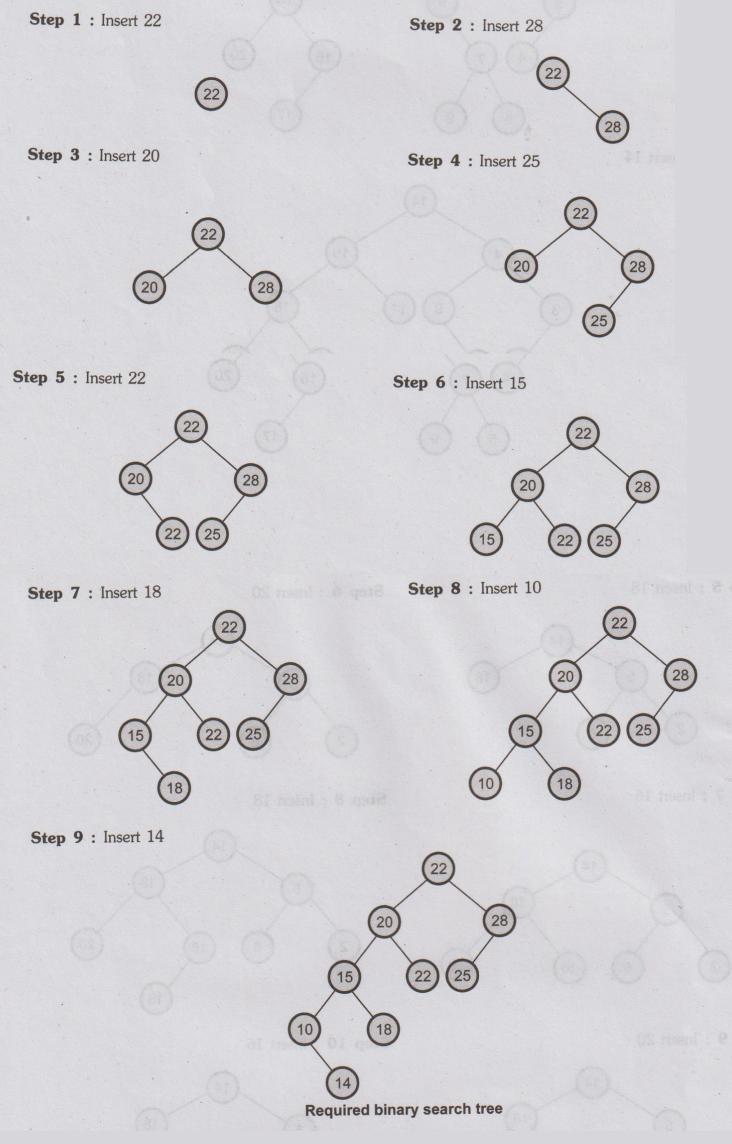
Recursive
Algorithm for search - Refer example 5.6.4.
Ex.
5.6.3: What is binary search tree? Draw the binary search tree for the
following input. 14, 5, 6, 2, 18, 20, 16, 18, -1, 21.
Sol.
Binary Search Tree : Refer section 5.6.
Example

Ex.
5.6.4: What is binary search tree? Write a recursive search routine for binary
search tree.
Sol.
Binary Search Tree: Refer section 5.6.
Recursive
Search Routine
node
*search(node temp, int key)
{
if
(temp == NULL || key == temp.data)
return
temp;
else
if
(key<temp.data)
return
search(temp->left, key);
else
return
search(temp->right,key);
}
Ex.
5.6.5 Write the following routines to implement the basic binary search tree
operations
AU:
Dec.-18, Marks 13
(i) Perform search operation in binary search
tree signs
(ii)
Find_min and Find_max
Sol.:
(i) Search operation - Refer section 5.6.1.
(ii)
Find_min and Find_max
Consider
following binary search tree

For
finding the minimum value from the binary search tree, we need to traverse to
the left most node. Hence the left most node in above Fig. 5.6.11 is with value
7 which is the minimum value. Note that for the leftmost node the left
pointer is NULL.
The
routine for finding the minimum value from the binary search tree is,
Find_min(node
*root)
{
struct
node* current=root;
while(current->left
!= NULL)
current=current->left;
printf("%d",
current->data);
}
For
finding the maximum value from the binary search tree, we need to traverse to
the right most node. Hence the right most node in above Fig. 5.6.11 is with
value 13 which is the maximum value. Note that for the rightmost node the right
pointer is NULL. The routine for finding the maximum value from the binary
search tree is Find_max(node *root)
{
struct
node* current=root;
while(current->right
!= NULL)
current-current->right;
printf("%d",
current->data);
}
Review Questions
1. Write a iterative search routine for a binary search tree.
2. Describe the binary search tree with an example. Write a
iterative function to search for the key value in binary search tree. esmito
giarollo sit stiW 2.8.2
3. How to insert and delete an element into binary search tree
and write down the code for the insertion routine with an example. dose grandi
moitos
AU: Dec.-19, Marks 13
C Programming and Data Structures: Unit IV: a. Non-Linear Data Structures - Trees : Tag: : Definition, Operations, Algorithm, Structure, Example C programs | Non-Linear Data Structures - Binary Search Tree
Related Topics
Related Subjects
C Programming and Data Structures
CS3353 3rd Semester EEE, ECE Dept | 2021 Regulation | 3rd Semester EEE Dept 2021 Regulation
